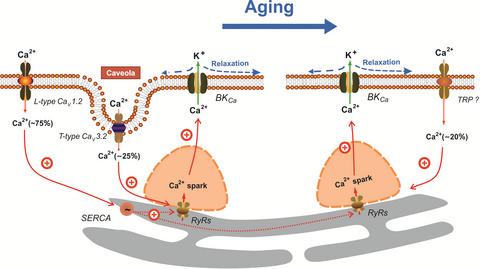当前位置:
X-MOL 学术
›
Aging Cell
›
论文详情
Our official English website, www.x-mol.net, welcomes your
feedback! (Note: you will need to create a separate account there.)
Age attenuates the T-type CaV 3.2-RyR axis in vascular smooth muscle.
Aging Cell ( IF 8.0 ) Pub Date : 2020-03-18 , DOI: 10.1111/acel.13134 Gang Fan 1, 2 , Mario Kaßmann 1 , Yingqiu Cui 1 , Claudia Matthaeus 3 , Séverine Kunz 4 , Cheng Zhong 1 , Shuai Zhu 2 , Yu Xie 2 , Dmitry Tsvetkov 1 , Oliver Daumke 3, 5 , Yu Huang 6 , Maik Gollasch 1, 7, 8
Aging Cell ( IF 8.0 ) Pub Date : 2020-03-18 , DOI: 10.1111/acel.13134 Gang Fan 1, 2 , Mario Kaßmann 1 , Yingqiu Cui 1 , Claudia Matthaeus 3 , Séverine Kunz 4 , Cheng Zhong 1 , Shuai Zhu 2 , Yu Xie 2 , Dmitry Tsvetkov 1 , Oliver Daumke 3, 5 , Yu Huang 6 , Maik Gollasch 1, 7, 8
Affiliation

|
Caveolae position CaV3.2 (T‐type Ca2+ channel encoded by the α‐3.2 subunit) sufficiently close to RyR (ryanodine receptors) for extracellular Ca2+ influx to trigger Ca2+ sparks and large‐conductance Ca2+‐activated K+ channel feedback in vascular smooth muscle. We hypothesize that this mechanism of Ca2+ spark generation is affected by age. Using smooth muscle cells (VSMCs) from mouse mesenteric arteries, we found that both Cav3.2 channel inhibition by Ni2+ (50 µM) and caveolae disruption by methyl‐ß‐cyclodextrin or genetic abolition of Eps15 homology domain‐containing protein (EHD2) inhibited Ca2+ sparks in cells from young (4 months) but not old (12 months) mice. In accordance, expression of Cav3.2 channel was higher in mesenteric arteries from young than old mice. Similar effects were observed for caveolae density. Using SMAKO Cav1.2−/− mice, caffeine (RyR activator) and thapsigargin (Ca2+ transport ATPase inhibitor), we found that sufficient SR Ca2+ load is a prerequisite for the CaV3.2‐RyR axis to generate Ca2+ sparks. We identified a fraction of Ca2+ sparks in aged VSMCs, which is sensitive to the TRP channel blocker Gd3+ (100 µM), but insensitive to CaV1.2 and CaV3.2 channel blockade. Our data demonstrate that the VSMC CaV3.2‐RyR axis is down‐regulated by aging. This defective CaV3.2‐RyR coupling is counterbalanced by a Gd3+ sensitive Ca2+ pathway providing compensatory Ca2+ influx for triggering Ca2+ sparks in aged VSMCs.
中文翻译:

年龄减弱了血管平滑肌的T型CaV 3.2-RyR轴。
小窝位置Ca V 3.2(由α-3.2亚基编码的T型Ca 2+通道)足够接近RyR(ryanodine受体),可引起细胞外Ca 2+大量涌入,触发Ca 2+火花和大电导Ca 2+激活血管平滑肌中的K +通道反馈。我们假设Ca 2+火花生成的这种机制受年龄的影响。使用来自小鼠肠系膜动脉的平滑肌细胞(VSMC),我们发现Ni 2+(50 µM)对Ca v 3.2通道的抑制和甲基ß-环糊精对海绵体的破坏或对含Eps15同源域蛋白(EHD2)的遗传废除)抑制钙幼鼠(4个月)而不是老年鼠(12个月)的细胞中产生2+种火花。因此,年轻小鼠的肠系膜动脉中Ca v 3.2通道的表达高于老年小鼠。对于小窝密度观察到类似的效果。使用SMAKO Ca v 1.2 -/-小鼠,咖啡因(RyR激活剂)和毒胡萝卜素(Ca 2+转运ATPase抑制剂),我们发现足够的SR Ca 2+负载是Ca V 3.2-RyR轴生成Ca 2的先决条件+火花。我们在老化的VSMC中确定了一部分Ca 2+火花,该火花对TRP通道阻滞剂Gd 3+(100 µM)敏感,但对Ca V不敏感1.2和Ca V 3.2通道封锁。我们的数据表明,VSMC Ca V 3.2-RyR轴会因老化而下调。这种有缺陷的Ca V 3.2-RyR耦合通过Gd 3+敏感的Ca 2+途径抵消,该途径提供补偿性Ca 2+流入,以触发老化的VSMC中的Ca 2+火花。
更新日期:2020-03-18
中文翻译:

年龄减弱了血管平滑肌的T型CaV 3.2-RyR轴。
小窝位置Ca V 3.2(由α-3.2亚基编码的T型Ca 2+通道)足够接近RyR(ryanodine受体),可引起细胞外Ca 2+大量涌入,触发Ca 2+火花和大电导Ca 2+激活血管平滑肌中的K +通道反馈。我们假设Ca 2+火花生成的这种机制受年龄的影响。使用来自小鼠肠系膜动脉的平滑肌细胞(VSMC),我们发现Ni 2+(50 µM)对Ca v 3.2通道的抑制和甲基ß-环糊精对海绵体的破坏或对含Eps15同源域蛋白(EHD2)的遗传废除)抑制钙幼鼠(4个月)而不是老年鼠(12个月)的细胞中产生2+种火花。因此,年轻小鼠的肠系膜动脉中Ca v 3.2通道的表达高于老年小鼠。对于小窝密度观察到类似的效果。使用SMAKO Ca v 1.2 -/-小鼠,咖啡因(RyR激活剂)和毒胡萝卜素(Ca 2+转运ATPase抑制剂),我们发现足够的SR Ca 2+负载是Ca V 3.2-RyR轴生成Ca 2的先决条件+火花。我们在老化的VSMC中确定了一部分Ca 2+火花,该火花对TRP通道阻滞剂Gd 3+(100 µM)敏感,但对Ca V不敏感1.2和Ca V 3.2通道封锁。我们的数据表明,VSMC Ca V 3.2-RyR轴会因老化而下调。这种有缺陷的Ca V 3.2-RyR耦合通过Gd 3+敏感的Ca 2+途径抵消,该途径提供补偿性Ca 2+流入,以触发老化的VSMC中的Ca 2+火花。











































 京公网安备 11010802027423号
京公网安备 11010802027423号